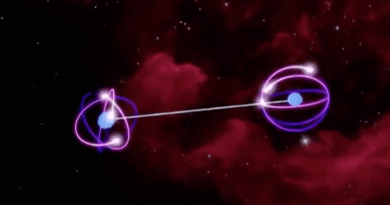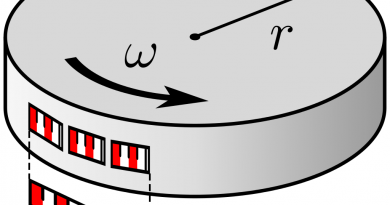One can’t unambiguously experimentally disprove the existence of a wormhole
Luboš Motl, September 21, 2015
Many people – including several famous physicists – find Maldacena’s and Susskind’s ER-EPR correspondence hard to believe, controversial, or inconsistent. But there is no known inconsistency. Three folks at Caltech, Bao, Pollack, and Remmen, are addressing a point that I have mentioned on this blog a few times, but they do so a bit differently.
Wormhole and Entanglement (Non-)Detection in the ER=EPR Correspondence
ER=EPR means that ER, an Einstein-Rosen bridge (a non-traversable wormhole), may always be interpreted as EPR (an acronym chosen for the quantum entanglement, after Einstein-Podolsky-Rosen, to make it sound funny), and vice versa. However, you could object that one can’t define a Yes/No observable that would measure the «existence of the entanglement». However, one may define an observable for «is there a wormhole», you could argue, so there is a contradiction.
This paper discusses the point that one can’t define either observable so everything is consistent.
First, why is «the existence of entanglement» not an observable? Well, take a two-spin Hilbert space, to pick an example. The states \(\ket{\uparrow\downarrow}\) and \(\ket{\downarrow\uparrow}\) are said to be non-entangled. So if there is an observable \(E\), a linear operator whose eigenvalues are \(0,1\) for non-entangled and entangled states, respectively, then both of the states I just wrote are the eigenstates with the eigenvalue \(E=0\).
However, because the operator is linear, any linear superposition of these states has to have be an eigenstate with the same eigenvalue \(E=0\) as both of them share. However,
\[ \ket{\uparrow\downarrow} — \ket{\downarrow\uparrow} \] is an example of a state (there are infinitely many) that is a linear superposition, but it is obviously not non-entangled. It is entangled. It should have a different eigenvalue \(E=1\) which proves that the linear operator cannot exist.
For certain reasons, they run the argument backwards and choose a basis composed of entangled states. They probably also want to exclude the possibility that \(E\) is an allowed nonlinear operator but I don’t understand how a nonlinear operator would be supposed to behave as an observable so I don’t see any value in their converse attitude.
OK, one can’t make an experiment that would prove or disprove that the two subsystems were entangled. After all, there is a simpler explanation. One may measure observables that obviously exist, e.g. the two spins separately, and the choice «which measurement we make» already implies whether the state will be entangled or non-entangled after the measurement.
If we measure the spins separately, we get either \(\ket{\uparrow\uparrow}\) or one of the three other options, and all these states are non-entangled! The non-entanglement is guaranteed already when we decide that we measure these «isolated properties» of the two subsystems. On the other hand, if we measure the total spin or something like that whose eigenstates are entangled states of the two spins, we’re guaranteed to bring the wave function into an entangled state after the measurement.
It means that the isolated measurements of the subsystems always eliminate the entanglement; and appropriate measurements of correlated properties of the two subsystems always create the entanglement. The «existence of entanglement» isn’t really associated with the a priori unknown outcomes of measurements; it is associated with the type of doable meaasurement that we decide to perform.
You could think that things are different on the gravitational side. You may measure whether the topology of the spacetime is one of a wormhole; or a topologically trivial one. However, as I mentioned many times (as a half-pedagogic, half-research contribution of mine), this is not the case. One actually can’t define observables (linear operators) for the spacetime topology.
Their explanation is a bit different from the prose I usually offer. They start by defining it by a single observer. One observer can’t guarantee that a wormhole exists or not exists because the wormhole in ER=EPR is non-traversible so he would die before he would complete the test of its existence. More nontrivially, they discuss the attempt to measure the existence of the wormhole by two or many observers. They fail because they may only start to collect evidence about the existence of the entanglement if they also start to measure the detailed properties of the arrangement inside the would-be wormhole.
(They mention lots of other possible hurdles; I don’t want to copy their paper here, however.)
So the two sides of ER=EPR agree that the «topological» property of the physical system (entanglement or wormholeness) can’t be associated with a well-defined linear operator.
My preferred comments about the similar questions are different. I say that to establish that two black hole interiors are connected by a wormhole, one has to see that these two black hole interiors contain «the same objects». But one may only measure the properties of the objects, e.g. spins of the electrons, and they may «happen» to look the same in both black hole interiors. But if two observers see objects (or sequences of spins) that look the same in two black holes, it doesn’t prove that they are the same objects, anyway. If you find two caves in Afghanistan and each of them contains a terrorist, it doesn’t mean that the caves are connected by a wormhole, or that it is the same cave. There may also be two twin Afghani terrorists over there.
At any rate, I agree with their conclusion and their general argumentation, too.
However, that only applies to the part of their paper about ER=EPR. Outside the main thread of their preprint, they also want to endorse some criticisms of the PR (Papadodimas-Raju) state dependence and these criticisms are wrong, as explained in several blog posts. In these «by the way» remarks of the new paper, these Caltech physicists imitate the completely wrong attitude by folks like Polchinski that «when things become hard, one has to talk about nonlinear operators all the time».
But the point of PR isn’t to talk about nonlinear operators; instead, the state-dependent operators are meant to be completely linear. But their precise form – matrix elements vis-a-vis a basis someone gave you – depends on the «situation». You may try to «beat» this state-dependence by defining operators that apply to all situations and that are allowed to be nonlinear. But you should not do such a thing because this goes totally against the lesson you should have learned from the state dependence. The lesson is that you should only use some field-like operators for a neighborhood of a microstate – only for a limited subspace which is obtained from a given microstate by a simple action of a polynomial or another simple function of field operators.
It’s a bit annoying that one can’t fully agree with even papers whose basic point is obviously right.


